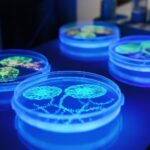
Applications of peptide libraries in fundamental and biotechnological research
The exploration of peptide libraries holds immense potential in both fundamental and biotechnological research. Due to their structural and functional diversity, peptides are critical for understanding peptide-protein interactions. Furthermore, studying phage display libraries and peptidomimetics accelerates research and provides new insights into this complex yet promising scientific field.
The definition of peptides
Thanks to their significant potential to modulate important biological functions, peptides have become increasingly used in fundamental and biotechnological research. These applications have opened new avenues for understanding and harnessing complex biological interactions, particularly in biochemistry, molecular biology, and biomolecular engineering research.
The design of peptide libraries
Designing peptide libraries is a critical process in biotechnological research. These collections allow for the testing of a vast range of biologically active compounds, providing researchers with a valuable tool to explore new biochemical interactions with target proteins.
Modern methodologies offer opportunities to develop innovative biotechnological solutions. The highly customizable nature of peptide libraries, where each peptide is unique in its sequence or spatial arrangement, enables researchers to explore various cellular activities through their interaction with proteins. This provides flexibility in discovering essential biochemical interactions and developing applications across diverse biotechnological fields.
However, as our ability to generate and explore these extensive virtual biochemical landscapes advances, significant challenges arise. These include the efficient management of resources, the time investment required to identify suitable candidates, and selecting appropriate screening techniques to navigate the vast diversity present within individual peptide libraries.
Phage display library creation
Creating phage display libraries involves a complex and essential process: cloning. The coding sequences of peptides are inserted into the DNA of a bacteriophage, a specific category of virus that infects only bacteria, using their mechanisms for replication. Cloning the coding sequences of peptides into the phage genome is typically done using two main methods:
- Homologous recombination: This approach uses bacterial cellular machinery to insert the coding sequences of peptides into the phage DNA through recombination between homologous sequences.
- CRISPR-Cas9 technology: The CRISPR-Cas9 system, consisting of a guide RNA and the Cas9 enzyme, allows for precise targeting of DNA sequences to insert genes encoding peptides of interest.
When these phages carrying the peptide coding sequence attach to their host, they inject their modified genetic material, leading to the mass production of the target peptide.
Studying peptide-protein interactions
These approaches deepen our understanding of complex biological systems and pave the way for innovations in biomolecular engineering. They play a vital role in exploring intricate biochemical mechanisms, which could have significant implications for numerous biotechnological applications.
Applications in fundamental research and biotechnology
Peptide libraries have proven to be invaluable tools in studying molecular interactions, particularly within structural biochemistry. They facilitate the identification of novel biomarkers and the exploration of essential biological targets. In biotechnology, these libraries enable:
- The discovery and validation of innovative targets.
- The development of more precise and specific research tools.
- A better understanding of the underlying processes of complex biological mechanisms.
- Endless possibilities for comparative studies across various model organisms.
- Detailed insights into the global interactions of biologically relevant cells.
Optimizing signaling pathways
New tools for scientific progress
Peptidomimetic libraries
Peptidomimetic libraries consist of molecules that mimic the structure of natural peptides. These entities are used to explore new biochemical interactions and develop innovative approaches in biomolecular research. Due to their structural diversity, these molecules allow the modeling of complex interactions and the identification of specific targets across various biological systems. From creating functional probes to studying ligand-receptor interactions, peptidomimetic libraries offer new opportunities to explore and exploit complex biological mechanisms in various biotechnological applications.
In summary, peptide and peptidomimetic libraries are invaluable assets in scientific and biotechnological research. Their ability to explore a wide range of molecular interactions presents innovative opportunities for developing new materials, catalysts, and analytical tools. These libraries push the boundaries of chemical and molecular engineering, opening the door to novel applications across various industries. By continuing to harness their potential, the technological and scientific advances derived from this research could transform multiple fields while enhancing the efficiency and precision of development processes.
Cox, J., 2023. Prediction of peptide mass spectral libraries with machine learning. Nature Biotechnology, 41(2), pp.234-245. doi:10.1038/s41587-022-01474-9.
Goto, Y., and Suga, H., 2021. The RaPID platform for the discovery of pseudo-natural macrocyclic peptides. Accounts of Chemical Research, 54(2), pp.360-372. doi:10.1021/acs.accounts.0c00554.
Jaroszewicz, W., Morcinek-Orłowska, J., and Sobolewski, W., 2022. Phage display and other peptide display technologies. FEMS Microbiology Reviews, 46(3), pp.569-590. doi:10.1093/femsre/fuab046.
Kondo, E., Iioka, H., and Saito, K., 2021. Tumor‐homing peptide and its utility for advanced cancer medicine. Cancer Science, 112(2), pp.567-575. doi:10.1111/cas.14793.
Li, X., Craven, T.W., and Levine, P.M., 2022. Cyclic peptide screening methods for preclinical drug discovery: Miniperspective. Journal of Medicinal Chemistry, 65(4), pp.2202-2215. doi:10.1021/acs.jmedchem.1c00987.
Muttenthaler, M., King, G.F., Adams, D.J., and Alewood, P.F., 2021. Trends in peptide drug discovery. Nature Reviews Drug Discovery, 20(4), pp.309-325. doi:10.1038/s41573-020-00135-8.
Qi, Y.K., Zheng, J.S., and Liu, L., 2024. Mirror-image protein and peptide drug discovery through mirror-image phage display. Chem, 10(1), pp.45-60. doi:10.1016/j.chempr.2023.08.012.
Sharma, K., Sharma, K.K., Sharma, A., and Jain, R., 2023. Peptide-based drug discovery: Current status and recent advances. Drug Discovery Today, 28(4), pp.789-800. doi:10.1016/j.drudis.2022.12.008.
Shinbara, K., Liu, W., Van Neer, R.H.P., and Katoh, T., 2020. Methodologies for backbone macrocyclic peptide synthesis compatible with screening technologies. Frontiers in Chemistry, 8(5), pp.100-115. doi:10.3389/fchem.2020.00823.
Sohrabi, C., Foster, A., and Tavassoli, A., 2020. Methods for generating and screening libraries of genetically encoded cyclic peptides in drug discovery. Nature Reviews Chemistry, 4(10), pp.680-695. doi:10.1038/s41570-020-00224-8.



